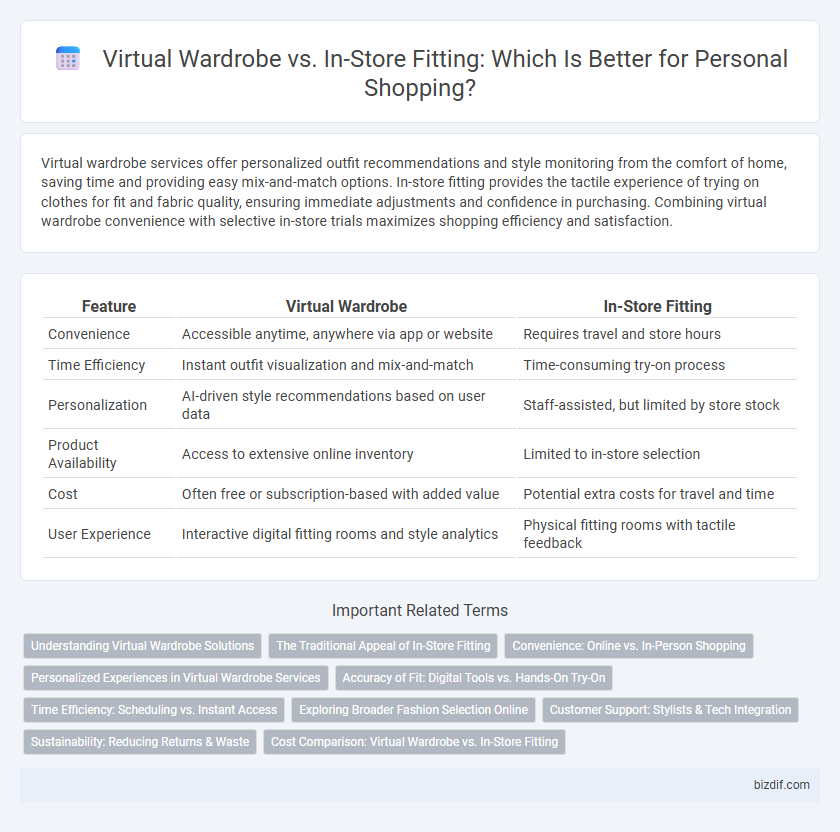Virtual wardrobe services offer personalized outfit recommendations and style monitoring from the comfort of home, saving time and providing easy mix-and-match options. In-store fitting provides the tactile experience of trying on clothes for fit and fabric quality, ensuring immediate adjustments and confidence in purchasing. Combining virtual wardrobe convenience with selective in-store trials maximizes shopping efficiency and satisfaction.
Table of Comparison
| Feature | Virtual Wardrobe | In-Store Fitting |
|---|---|---|
| Convenience | Accessible anytime, anywhere via app or website | Requires travel and store hours |
| Time Efficiency | Instant outfit visualization and mix-and-match | Time-consuming try-on process |
| Personalization | AI-driven style recommendations based on user data | Staff-assisted, but limited by store stock |
| Product Availability | Access to extensive online inventory | Limited to in-store selection |
| Cost | Often free or subscription-based with added value | Potential extra costs for travel and time |
| User Experience | Interactive digital fitting rooms and style analytics | Physical fitting rooms with tactile feedback |
Understanding Virtual Wardrobe Solutions
Virtual wardrobe solutions leverage AI technology to create personalized digital closets, enabling users to mix and match outfits without physical trials. These platforms analyze body measurements, style preferences, and current fashion trends to recommend pieces that fit and flatter individual shapes. Virtual wardrobes reduce the hassle of in-store fitting by offering instant, accurate outfit previews that enhance convenience and decision-making.
The Traditional Appeal of In-Store Fitting
In-store fitting offers a tactile and immersive experience where customers can physically try on garments, ensuring perfect fit and fabric feel, which virtual wardrobes cannot fully replicate. The immediate feedback from mirrors and sales associates helps shoppers make confident decisions, minimizing the risk of returns. This hands-on approach maintains its appeal for consumers seeking personalized style advice and instant gratification.
Convenience: Online vs. In-Person Shopping
Virtual wardrobe platforms offer unparalleled convenience by allowing users to try and mix outfits digitally anytime without geographical constraints. In-store fitting provides the tactile experience of physically assessing fabric, fit, and comfort, but requires time and travel to the location. Personalized shopping apps integrate virtual wardrobe tools with real-time inventory, bridging convenience with immediate purchase options.
Personalized Experiences in Virtual Wardrobe Services
Virtual wardrobe services leverage AI-driven algorithms to offer highly personalized styling recommendations based on individual body measurements, preferences, and past purchases, enhancing the shopping experience beyond traditional in-store fittings. These platforms use augmented reality and 3D visualization to enable precise outfit trials from home, reducing the need for physical dressing rooms and increasing consumer confidence in fit and style. Personalized experiences in virtual wardrobes also include real-time feedback and curated wardrobe suggestions, making the process more efficient and tailored compared to conventional in-store shopping scenarios.
Accuracy of Fit: Digital Tools vs. Hands-On Try-On
Virtual wardrobe technologies utilize 3D body scanning and AI algorithms to provide highly accurate size recommendations based on precise measurements and past purchase data. In-store fitting allows consumers to physically try on garments, offering tactile feedback and instant assessment of comfort and fit, which digital tools cannot fully replicate. Combining virtual fitting precision with in-person adjustments optimizes overall fit accuracy and reduces return rates.
Time Efficiency: Scheduling vs. Instant Access
Virtual wardrobe services offer time-efficient scheduling by allowing users to browse and plan outfits anytime without the constraints of store hours, reducing the need for physical visits. In contrast, in-store fitting provides instant access to try on items immediately, saving time on returns and exchanges but requires coordinating store hours and potentially waiting for assistance. Choosing between virtual wardrobe and in-store fitting depends on whether users prioritize flexible scheduling or immediate, hands-on experience.
Exploring Broader Fashion Selection Online
Virtual wardrobe solutions offer access to an extensive range of clothing brands and styles beyond local store inventories, enabling users to explore the latest trends globally. Online platforms provide personalized recommendations based on user preferences, size data, and style history, enhancing the shopping experience. This broader selection in virtual wardrobes supports more informed choices compared to the limited options typically available during in-store fittings.
Customer Support: Stylists & Tech Integration
Virtual Wardrobe platforms leverage advanced AI technology and expert stylists to offer personalized customer support, enhancing outfit recommendations based on real-time data and virtual try-ons. In-store fitting provides face-to-face assistance from professional stylists, allowing immediate feedback and hands-on adjustments for a tailored shopping experience. Integration of tech tools in both methods streamlines customer interactions, but virtual wardrobes excel in convenience and data-driven styling guidance.
Sustainability: Reducing Returns & Waste
Virtual wardrobe technology significantly reduces product returns by allowing customers to visualize clothing fit and style digitally, minimizing the environmental impact of excessive shipping and packaging waste. In-store fitting rooms often lead to higher return rates due to impulse purchases and inaccurate fit estimations, contributing to increased textile waste and carbon emissions. Emphasizing virtual wardrobes supports sustainable shopping habits by encouraging more accurate buying decisions and lowering the carbon footprint associated with reverse logistics.
Cost Comparison: Virtual Wardrobe vs. In-Store Fitting
Virtual wardrobe services offer significant cost savings by eliminating travel expenses, reducing the need for multiple purchases, and providing personalized recommendations through AI technology. In-store fittings often include hidden costs such as transportation, parking fees, and potential impulse buys that can increase the overall expenditure. Virtual wardrobes enhance budget efficiency by streamlining the selection process, ensuring investments in clothing align precisely with individual style and fit preferences.
Virtual Wardrobe vs In-Store Fitting Infographic

 bizdif.com
bizdif.com